People my age are acutely aware of their memories and the work of memory. It starts with our own effort to figure out what all these pictures are that were never put in an album, the backs of which are blank. Maybe we kept a fitful diary to help us. We are trying to sort the dates and faces out and make of our life a coherent, meaningful story, one that can inform our children and future generations. This leads us to our parents and grandparents, back to the stories that generated stories, the pictures of likenesses handed down by genetic code and geographical wanderings. This then becomes the search for the memory of a people, often worn away under neglectful feet, defaced by traumatic warfare and willful manipulation.
And so we are led to Egypt, whose long history evolved like silt along the single river that fed it —the Nile. Such a slender thread of water has knit together a series of kingdoms whose memory survived in stone monuments covered in symbols that shaped dozens of rituals by which the people remembered and hoped over the centuries. In Egypt memory is all about the monuments and their writings. But we are cut off from the lived reality of that ancient culture, first by the Christians, who defaced what statues they could, proclaiming the God revealed in Scripture and in Jesus. And then the Muslims came, disdaining even the Trinitarian monotheism of the Christians, smashing more idols, building their grand and austere mosques of word and obedient prayer.
We were in Egypt in February with Archaeological Paths, whose team of Polish and Egyptian leaders guided us through the melee of Cairo, the windswept desert, the placid Nile. Their principal lecturer is Dr. Zahi Hawass, whom many of you have seen as the face of Egyptian archaeology—the older man with the Stetson in the National Geographic films. That’s him. He began our stay by passionately telling us that he and many other Egyptians feared, and feared intensely, that the Muslim Brotherhood would bring in the kind of radicals who are now smashing antiquities in Iraq and Syria, just as they did in Afghanistan. They were going to destroy Egypt’s memory and with it the tourist influx that feeds its economy. Now, with a new stability and order, with many in prison or eliminated, they have a chance not only to preserve their priceless heritage but to build a democratic order. It is not merely a matter of whether they have the hope, but of whether they have the memory. What memory will inform this struggle for democracy?
The pyramids and temples we were about to see, said Hawass, constituted a vast “National Project” that united Upper and Lower Egypt, binding together the families, clans, villages
and kingdoms that lay along the Nile. That, he said, is what Egypt needs today. For him, it is the national project of discovering, preserving and sharing their unique cultural heritage with and for the world. Hawass has been central to the discovery of some of the villages where the workers, architects, artists, and managers lived as they spent their lives on these vast public works. They have never discovered any evidence that slaves built the pyramids. In their recovery of memory, the memory of Jews, Christians, and Muslims fed by the Bible is called into question. The clash of memory becomes a conflict in faith, a resettling of the religion that is the template of our collective memory.
Indeed, we can look at the murderous mayhem and butchery that burns in the region as a frantic struggle over memory—the memory of origins, of imperial oppression, colonial subordination and liberation, of future allegiances and hopes. In memory lie our burnished fears and our bonds of primordial trust.
But looking into memories does not merely open up the raw sores of conflict, it also exposes continuities that both disturb and clarify. In temple after temple we would come across some portrayal of a “Triad” of Gods, whether of Ptah the creator, Sekmet the warrior, and Nefertum the Healer, or Sobek the crocodile god, Hathor, the goddess of love, joy, and fertility, and Khonsu the god of the moon and fertility. Each place, it seems, had its own Triad. At Abu Simbel, on Lake Nasser (another National Project!), Ramses II modestly included himself to form a foursome. And so I thought about the Trinity, which brings the transcendent God into contact with frail and fleeting humanity. Is this where our concept of the Trinity was born?
And how many times did we see Horus seated, often suckling, on the lap of Isis? Horus was the son of the union between Isis and her brother Osiris. He was dismembered by his fratricidal brother Seth, and resurrected to sit upon the throne that she herself represents. And all of this, I presume, flowed through the theologians of Alexandria into our own Christian creeds, icons, and rituals in the form of the Madonna, suckling the King of the Universe.
And in other places we saw wall carvings of the
anointing of the king with water from the Nile, pouring over him in the same way that Baptism is depicted in the “Hanging Church” of the Coptics in Cairo.
At the core of their ritual was the journey across the river of the deceased king, in whose future immortal life the continuity, stability, and order of their world would be preserved. For them it was the Nile, but for my Christian tradition, especially for our Gospel songs, it is the Jordan. How deep the river runs.
And then, what about the flight of Joseph, Mary, and Jesus into Egypt? We rehearsed this memory by visiting the church that legend says is built where they were lodged. A
Bethlehem of refuge from the evil powers. In encountering Egypt’s memory I began to think that maybe the flight went the other way. The image of the Holy family fled out of Egypt to impregnate the fledging Christ movement with its comforting memory of mother love and father care.
The strands of incarnate fleshly care in Egyptian symbolism were momentarily shattered by Akhenaten’s attempt to introduce a monotheism of the sun, whose delicate hands extend to every arena of life from the one unifying ball of heat and light. And in that brief flicker, some say, the one who came to be called Moses caught the monotheistic vision and burned it into the heart of a people who carried it off to a rocky land called Israel.
And then came Muhammad of Mecca and Medina, who lit up the warring tribes of Arabia to unify around this transcendent unseeable, untouchable God and so bring peace. Yet still the tribes war on, murdering mothers, fathers, and babes, murdering our rich, conflicting, and disturbing memories.
Yes, Egypt was the awesome monuments, the overwhelming artistic achievements in tomb and temple, the muezzin’s call from minarets along the Nile, the chaos that is Cairo traffic, but it was also the tanks and guns that say “We are watching. There will be order.” There will be continuity and memory. But will it be a memory of democratic governance or of monarchical military rule? That is the question.
The Nile still rolls on, now tamed by the enormous Aswan dam. As I stood on top of it, looking at the hydroelectric plant below, I realized that if this dam broke, the entire country of Egypt would be scoured into oblivion. The dam still holds, for now. But some say that cracks are developing in it. Some deep hidden fault. Visit Egypt now. And remember.

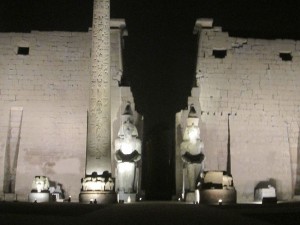
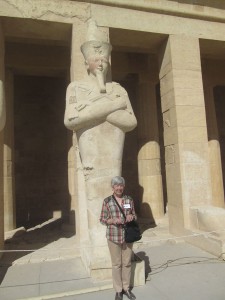
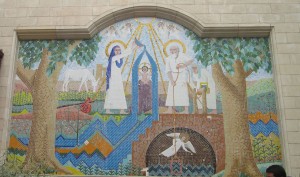
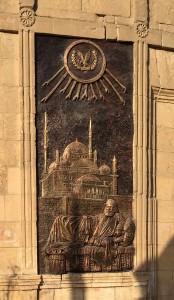
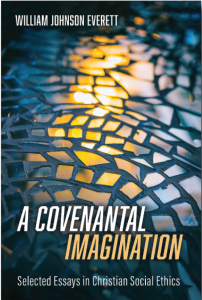
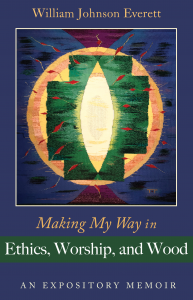
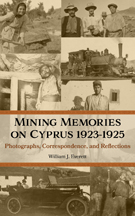
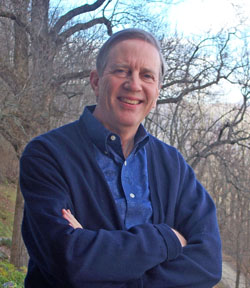
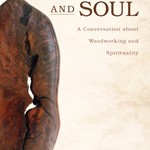
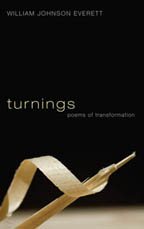
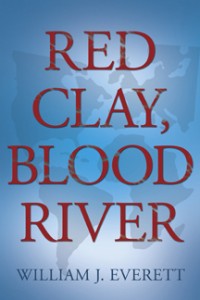 Red Clay, Blood River
Red Clay, Blood River
What a beautiful sweep of history which puts own endeavors into pale contrast–yet gives us touch points for looking at our present, anticipating our future. Thanks, Bill.